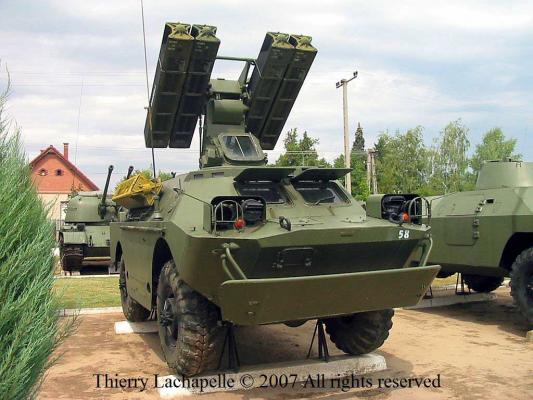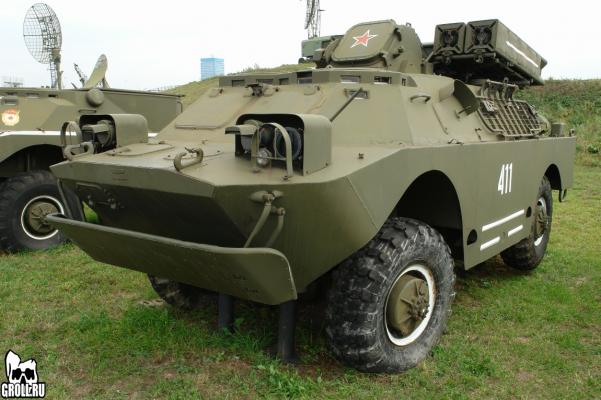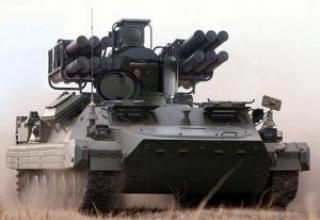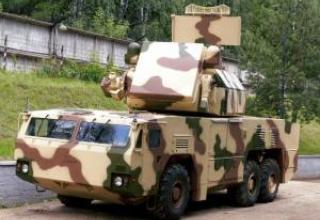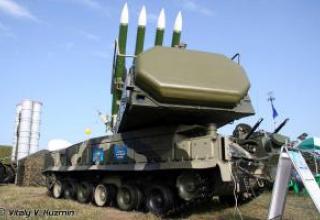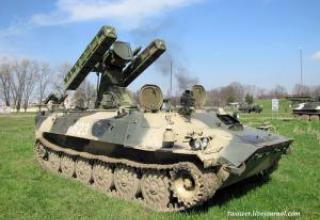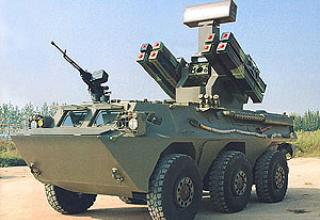Development of the regimental self-propelled air defense missile system "Arrow-1" began on August 25, 1960 in accordance with the Decree of the USSR CM. The Decree provided for the creation of a lightweight man-portable air defense system, consisting of two parts with a mass of no more than 10-15 kg each. The complex was designed to engage air targets flying at speeds up to 200-250 m/s at altitudes from 50-100 m to 1000-1500 m at a range of 2 km.
The head designer of the complex as a whole and ZUR was appointed OKB-16 GKOT, later transformed into the Design Bureau of Precision Engineering (KBTM) MOP (Chief Designer A.E.Nudelman). V.A.Khrustalev was determined to be the Chief Designer of the Homing Optical Head for the ZSD, and the Designer Organization was determined to be TsKB-589 GKOT. Subsequently, this organization was transformed into the Central Design Bureau "Geophysics" of the Ministry of Defense, and the work on GSN for LSD "Arrow" was headed by D.M.Khorol.
In accordance with the same Resolution, another portable SAM system was also developed - "Arrow-2". The weight and dimensions of this SAM system were less than those of the Arrow-1 complex. Initially, the development of the Arrow-1 SAM system to some extent insured the Arrow-2 complex, due to a higher degree of technical risk. After resolving the main fundamental issues related to the development of the Arrow-2 complex, the issue of the future fate of the Arrow-1 SAM system, which had almost the same flight characteristics, was raised. In this situation, it was decided to set higher requirements for the Arrow-1 SAM system in terms of maximum range (up to 5 km) and altitude (up to 3500 m), abandoning the portable design of the complex and moving to the SAM system with placement on a car chassis (it was planned to increase the weight and dimensions of the missile). Later on, the BRDM-2 armored reconnaissance road vehicle was used as a base for the Strela-1 self-propelled air defense system.
The concept of combat use of Strela-2 and Strela-1 systems was also defined. The Strela-2 portable system is used in the battalion-sized air defense, while the Strela-1 self-propelled system is used in the regiment, in addition to the Shilka anti-aircraft self-propelled system, the range of which (2.5 km) does not ensure the enemy aircraft and helicopters to the point of launch of guided missiles on the positions and objects of the motorized rifle (tank) regiment (4 ... 5 km). Thus, the Arrow-1 SAM system with an extended kill zone fit well into the military air defense system under development.
State trials of the Arrow-1 prototype complex were conducted in 1968. The complex was adopted by the Decree of the CPSU Central Committee and the USSR CM on April 25, 1968. The serial production of the 9A31 Arrow 1 SAM system was launched at the Saratov MOS Aggregate Plant, 9M31 missiles - at the Kovrov Mechanical Plant of MOS.
Composition:
Combat vehicle 9A31 SAM system "Arrow-1" was equipped with a launcher with four SAMs in transport and launch containers, equipment for launching SAMs, optical detection and sighting, as well as communications equipment.
During the development of the 9K31 Arrow-1 complex, unlike other short-range SAMs, it was adopted that the missile would use a photocontrast CNS rather than an infrared (thermal) one. In those years, the low sensitivity of infrared CNSs did not provide a target in the front hemisphere, and therefore, the enemy aircraft could only be fired at "inhalation". In such tactical conditions, it was quite possible to destroy the SAMs even before they launched anti-aircraft missiles. On the contrary, the use of photocontrast CNS made it possible to fire targets on counter courses.
The complex could fire at aircraft and helicopters flying at altitudes of 50 to 3,000 m at speeds of up to 310 m/s on counter courses and up to 220 m/s on catch-up courses with course parameters of up to 3,000 m, as well as at dependent helicopters and drifting aerostats. Photocontrast CNS capabilities allowed shooting only at visually visible targets against the background of clear sky or solid cloud cover, at angles between the target and the sun more than 20° and at angular exceeding of the target sighting line over the visible horizon more than 2°. Dependence on the illumination of the target, weather conditions and background conditions limited the combat use of the complex "Arrow-1". However, the average estimates of this dependence, taking into account the possibility of enemy aviation, as a rule, only in the same conditions, and in the future - as well as the practical application of the complex on exercises and military conflicts have shown that the SAM system "Arrow-1" could be used quite often and effectively (in military and economic terms).
In order to reduce the cost and improve the reliability of the combat vehicle, the launcher was guided on the target by the operator's muscular efforts. With the help of a system of lever and parallelogram devices, he manually pointed the launcher at the required angle of space (in the range from -5° to +80°) connected to each other the launch frame with the missiles, lens of optical sighting device and rough sighting device, and by means of his legs, connected to the seat of knee supports, rounded the launcher on azimuth, repelling from the cone fixed on the floor of the machine. The front wall of the 60° azimuth operator tower was made of clear bulletproof glass. In the transport position, the PU was lowered to the roof of the combat vehicle.
Shooting on the move was achieved by almost full natural balance of the oscillating part and by aligning the center of gravity of the PU with the missiles with the point of intersection of the machine's oscillating axes, due to the human-operator's ability to counteract low-frequency vibrations of the machine's hull.
Anti-aircraft guided missile 9M31
The 9M31 anti-aircraft guided missile (see diagram) was guided by the aerodynamic "duck" pattern and aimed at the target by means of CNS using the proportional navigation method. The COS transformed the radiant energy flux from a contrasting target in the sky into an electrical signal containing information about the angle between the COS coordinator's axis and the target-rocket sighting line, as well as the value of the angular velocity of the sighting line. Uncooled lead-sulfur photoresistance was used as the sensitive elements of the CNS.
The steering wheel drive of triangular aerodynamic rudders, control system equipment, combat unit and optical fuse were sequentially located behind the CNS. Then installed a solid propellant rocket engine, the tail compartment of which were fixed trapezoidal missile wings. The missile used a single-chamber dual-mode solid propellant rocket engine. At the launch site, the rocket was accelerated to a speed of about 420 m/s, which was then maintained approximately constant on the march site.
The rocket hasn't stabilized on the heel. Angular velocity relative to the longitudinal axis was limited by the use of rollers - a kind of small rudders on the wing (tail fins), inside which were mounted disks associated with the wheels. The gyroscopic moment from the quick-rotating discs unfolded the rolleron in such a way that the resulting aerodynamic force slowed down the tilting rotation of the rocket. Such a device was first used on the U.S. air-to-air missile "Sidewinder" and its Soviet copy of K-13, launched at the same time with the beginning of development of "Arrow-1". However, on these missiles rollers with small blades around the circumference spun long before the launch of the rocket under the influence of the air flow, flowing aircraft carrier. For the timely promotion of Rolleron SAM system designers of Arrow-1 used an elegant and simple device. A cable was wrapped around the rolleron, with the free end fixed to the TPC. At startup the rollers were spun with a cable according to the scheme similar to that used for starting boat motors.
In case of direct hit to the target contact magnetoelectric sensor, and in case of missile overflight near the target - non-contact electron-optical sensor, engaged a safety executive mechanism (PIM) to undermine the combat unit of the SAM. In case of a large miss, the safety executive mechanism was withdrawn from the combat position after 13 ... 16 s and could not blow up the BC any more. When it fell to the ground, the SAM system did not explode, but deformed without causing significant damage to its troops.
The length of the missile was about 1.8 m, diameter - 120 mm, wingspan - 360 mm.
Along with the missile portable complex "Arrow-2", missile 9M31 was one of the first two domestic SAMs, which were stored, transported in a transport and launch container and launched directly from it. The spray protective transport and launch container 9Y23, which protected the missile from mechanical damage, was attached to the PU frame using rods.
Organizational structure and combat work.
Strela-1" complexes were part of the platoon (four combat vehicles) in the anti-aircraft missile artillery battery ("Arrow-1" - "Shilka") motorized rifle (tank) regiment.
The combat operations of the Arrow-1 SAM system were conducted in the following order. When the target designation was received or when the shooter-operator independently visually detected the target, he guided the launcher from the SAM to the target, using an optical sight to improve accuracy. At the same time, the power to the board of the first SAM was switched on (after 5 seconds - the second SAM) and the covers of the transport and launch containers were opened. Having heard the sound signal about the CNS target capture and visually assessed the moment of target entry into the launch area, the operator pressed the "Launch" button to launch the missile. While the missile was moving along the container, the electric power cable of the SAM was cut off, and the first stage of protection was removed in the safety executive mechanism. Shooting was carried out according to the principle "shot and forgot".
According to the test results, the probability of hitting a single SAM when firing towards a target flying at 200 m/s at 50 m height was determined. They ranged from 0.15 to 0.64 for a bomber and from 0.1 to 0.6 for a fighter. When target speed increased to 300 m/s and altitude to 1000 m, the probabilities were 0.15 to 0.52 for the bomber and 0.1 to 0.42 for the fighter.
At shooting breathtaking, the probability of hitting the targets flying at the speed of 300 m/sec was 0.47 ... 0.49, and at the speed of 200 m/sec - 0.52 ... 0.65.
Upgrade.
In 1968-1970 the complex was modernized:
- A passive direction finder (SAM) developed by the Leningrad Research Institute "Vector" was introduced into the SAM system, which ensures the detection of targets with onboard radio facilities, their tracking and entry into the field of view of the optical visier, with the possibility of target designation according to the SAM data with the passive direction finder by another SAM "Arrow-1" of a simplified configuration - without a direction finder.
- Thanks to the missile's improvement, the close range of the target area of the complex was reduced, the probability of hitting targets at low altitudes and the accuracy of homing was increased.
- An inspection and verification machine has been developed to control the operation of the Arrow-1 system's standard warheads, taking into account the changes introduced into the system during its upgrade.
State tests of the upgraded Arrow-1M complex (see diagram, photo 1, photo 2) were conducted at the Dongguz firing range from May to July 1969. The Arrow-1M air defense system was adopted in December 1970.
According to the test results, the complex could provide defeat of aircraft and helicopters flying at speeds up to 310 m/s, at altitudes from 30 ... 40 to 3500 m, with exchange rate parameters up to 3500 m, and maneuvering with an overload up to 3 units at ranges from 500 ... 1600 to 4200 m.
In comparison with the Arrow-1 SAM system in the upgraded complex, the short-range kill zone border was reduced by 400...600 m, and the lower border - by 30 m.
The probability of hitting non-manoeuvring targets with uniform backgrounds increased and at target speed of 200 m/s at altitudes up to 50 m 0.15-0.68 for a bomber and 0.1-0.6 for a fighter. At target speed of 300 m/s at the altitude of 1000 m these indices were 0.15-0.54 and 0.1-0.7 respectively, and at target speed of 300 m/s these indices were 0.58-0.66 and 0.52-0.72 respectively.
The combat operation of the Arrow-1M SAM system had some peculiarities in comparison with the autonomous operation of the Arrow-1 systems. All systems in the platoon were oriented on the ground in a single coordinate system for the Arrow-1 anti-aircraft missile artillery battery - Shilka. Radio communication was maintained between the combat vehicles. The commander of the SAM system for light and sound indicators of all-around visibility controlled the radio technical situation in the passive direction finder area. When the light and sound signals appeared, the commander assessed the state of the target and after making a decision about whether the signal belonged to the enemy aircraft's radar, he informed the operator of his combat vehicle, battery commander and other combat vehicles of the SAM platoon direction to the target. The battery commander provided target designation between the combat vehicles of the SAMs platoon and the SAMs. Upon receiving information about the target, the operator would activate the precise direction finding system, deploy the launcher to the target and, after confirming that the signal belonged to the enemy's assets, use the synchronous signals on the indicator light and in the helmet to accompany the target until it was in the field of view of the optical vizier, and then lead the launcher with the missiles to the target. The launcher was set in "Automatic" mode. When the target approached the launch area, the operator turned on the "Board" button, applied voltage to the ZAR and launched it. The "Forward"-"Backward" modes of operation provided in the complex allowed the operator, depending on the type, speed and position of the target relative to the complex, to shoot towards or inhale. Thus, when launching inhaling on all types of targets, as well as when launching towards a low-speed target (helicopter), the "Backward" mode was set.
The battery was controlled by the head of the air defense regiment through automated control points PU-12 (PU-12M), which he and the battery commander had. The commands, instructions and target designation data for "Arrow-1" SAMs from the PU-12 (PU-12M), which was the battery commander, were received through the communication channels formed by radio stations available on these means of destruction and control.
Characteristics:
| Complex | Arrow 1 | Arrow-1M | ||
| Rocket | 9М31 | 9М31 | ||
| Defeat zone, km | ||||
| - at a distance | 1..4,2 | 0,5..4,2 | ||
| - in height | 0,05..3 | 0,03..3,5 | ||
| - as defined in | up to 3 | up to 3,5 | ||
| Probability of hitting a single ZUR fighter. | 0,1..0,6 | 0,1..0,7 | ||
| Maximum target speed (up/down), m/s | 310/220 | 310/220 | ||
| The reaction time, s | 8,5 | 8,5 | ||
| ZUR flight speed, m/s | 420 | 420 | ||
| Weight of the ZUR, kg | 30 | 30,5 | ||
| Weight of combat unit, kg | 3 | 3 | ||
| The number of SSDs on a combat vehicle | 4 | 4 | ||
| Year of adoption | 1968 | 1970 | ||
Testing:
Strela-1 and Strela-1M complexes were widely exported by the USSR abroad. They were supplied to the countries-participants of the Warsaw Pact, to Yugoslavia, to the states of Asia (Iraq, Syria, North Yemen, India, Vietnam), Africa (Algeria, Angola, Benin, Egypt, Guinea, Guinea-Bissau, Libya, Madagascar, Mali, Mauritania, Mozambique) and Latin America (Cuba, Nicaragua), confirming their rather high efficiency and ease of use during military conflicts and during training firing.
The first use of the Arrow 1 SAM system was in the Bekaa Valley in southern Lebanon in 1981. In December 1983, these SAMs were shot down by American A-6E and A-7E aircraft (the latter, probably, was hit by portable SAMs of Strela-2 family). In the same year, several Arrow 1 SAM systems were captured by South African invaders in southern Angola.
Sources:
- Зенитные ракетные комплексы ПВО СВ. Техника и вооружения №5-6.99
- ARMY AIR DEFENCE
- Зенитный ракетный комплекс "Стрела-1"

